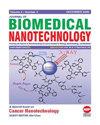Ferric Oxide Nanoparticles Enhance Cytotoxicity and Reduce the Occurrence and Development of Cervical Cancer Metastases
IF 2.9
4区 医学
Q1 Medicine
引用次数: 0
Abstract
Fe3O4 nanoparticles can be used in diagnostic imaging and therapeutic applications. However, poor solubility limits its use in tumors. In this study, we used ferric oxide and nanoparticles to covalently bind ferric oxide nanoparticles as a strategy for treatment of cervical cancer metastases. We aimed to evaluate their biological effects on cervical cancer metastases in vivo. Confocal microscopy was used to detect transfection efficiency, ferric oxide or ferric oxide nanoparticles were used to intervene cervical cancer cell lines, and flow cytometry explored cell apoptosis. The mouse model of cervical cancer metastasis was further treated with ferric oxide or ferric tetroxide nanoparticles through intraperitoneal injection. The tumor volume was counted and size was measured. Cell proliferation and apoptosis were detected by IHC and Western-blot was used to detect protein expression. Nanoparticles significantly enhanced the cellular uptake of Fe3O4, which inhibited cell proliferation and promoted cell apoptosis. In the in vivo transplanted tumor model, the same was observed in mice. In the mice model, ferric oxide nanoparticles significantly inhibited the growth of tumors, slowed down tumor growth rate, and accelerated apoptosis. Our research results showed that nanoparticles contributed to the uptake of oxidized particles, and Fe3O4 nanoparticles regulated studied tumors by enhancing cytotoxicity, thereby inhibiting cell proliferation and promoting cell apoptosis, achieving Fe3O4 nanoparticles. The particles significantly inhibited tumor growth, slowed down multiplication rate, and accelerated apoptosis, suggesting that Fe3O4 nanoparticles have a significant inhibitory effect on cervical cancer transplanted tumors.氧化铁纳米粒子增强细胞毒性,减少宫颈癌转移的发生和发展
Fe3O4 纳米粒子可用于诊断成像和治疗。然而,较差的溶解性限制了它在肿瘤中的应用。在这项研究中,我们使用氧化铁和纳米颗粒共价结合,作为治疗宫颈癌转移的一种策略。我们旨在评估它们对宫颈癌转移灶的体内生物效应。共聚焦显微镜用于检测转染效率,氧化铁或氧化铁纳米颗粒用于干预宫颈癌细胞系,流式细胞术用于检测细胞凋亡。通过腹腔注射氧化铁或四氧化三铁纳米颗粒进一步治疗宫颈癌转移小鼠模型。对肿瘤体积进行计数和测量。IHC 检测细胞增殖和凋亡,Western-blot 检测蛋白质表达。结果表明,纳米颗粒能明显增强细胞对Fe3O4的吸收,从而抑制细胞增殖,促进细胞凋亡。在小鼠体内移植肿瘤模型中也观察到了同样的效果。在小鼠模型中,纳米氧化铁明显抑制了肿瘤的生长,减缓了肿瘤生长速度,加速了细胞凋亡。我们的研究结果表明,纳米颗粒有助于氧化颗粒的吸收,Fe3O4 纳米颗粒通过增强细胞毒性来调节研究中的肿瘤,从而抑制细胞增殖,促进细胞凋亡,实现 Fe3O4 纳米颗粒。该粒子能明显抑制肿瘤生长,减缓繁殖速度,加速细胞凋亡,表明Fe3O4纳米粒子对宫颈癌移植瘤有明显的抑制作用。
本文章由计算机程序翻译,如有差异,请以英文原文为准。
求助全文
约1分钟内获得全文
求助全文
来源期刊
CiteScore
4.30
自引率
17.20%
发文量
145
审稿时长
2.3 months
期刊介绍:
Information not localized
文献相关原料
| 公司名称 | 产品信息 | 采购帮参考价格 |
|---|

 求助内容:
求助内容: 应助结果提醒方式:
应助结果提醒方式:


